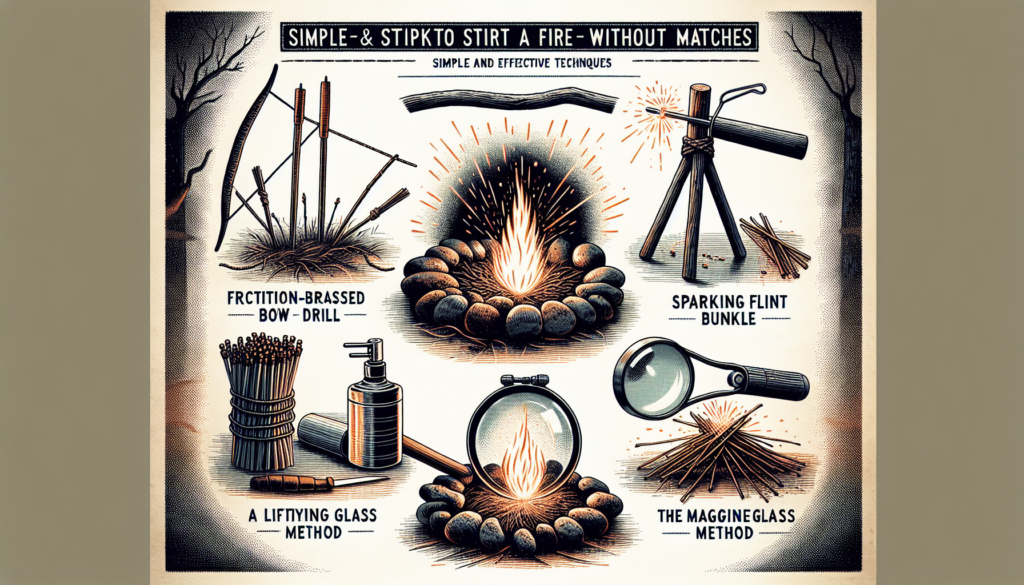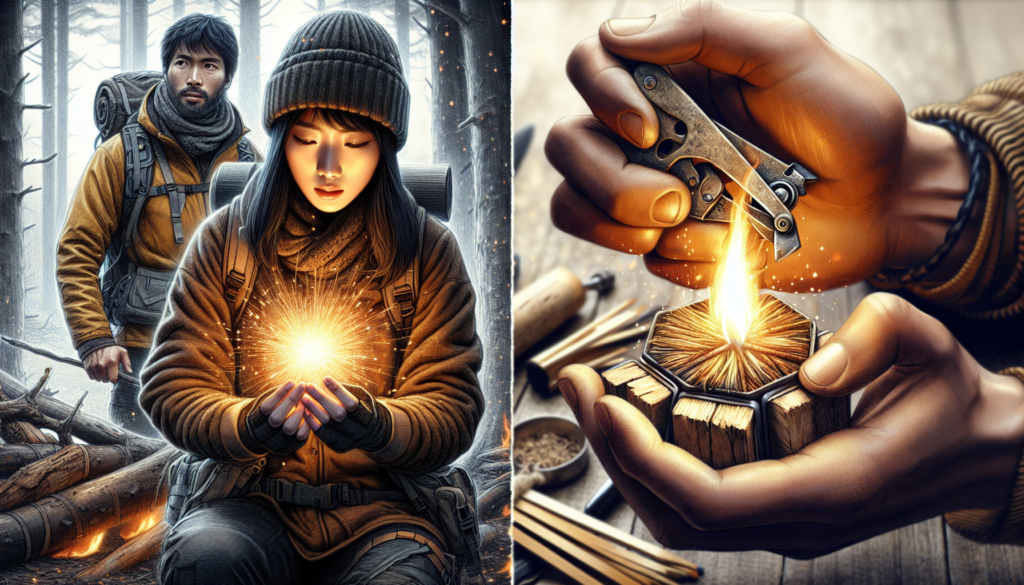In a world full of uncertainties, knowing how to start a fire without matches can be an essential skill to have. Whether you find yourself in the wilderness, facing a disaster in a city, or dealing with a life-threatening situation, having the knowledge to start a fire can provide comfort and potentially save lives. This article presents five easy methods to start a fire without matches, catering to a wide range of individuals – from beginners looking for introductory tips to experienced adventurers gearing up for extreme situations. With a focus on practicality, these methods will empower you to become self-reliant and resilient, helping you overcome challenges and emerge stronger.
Method 1: Friction-based Methods
Starting a fire using friction-based methods can be an effective and traditional way to ignite a flame without matches. Here are four popular friction-based methods:
Bow Drill Method
The bow drill method involves using a bow and spindle to generate friction and create an ember. To start, you will need a spindle, a fireboard, a bow, and a socket. By rapidly moving the bow back and forth, the friction between the spindle and fireboard creates heat, eventually creating an ember that can be used to start a fire.
Hand Drill Method
Similar to the bow drill method, the hand drill method utilizes friction to create a fire. Instead of using a bow, this method requires you to rotate the spindle rapidly with your hands. This technique requires practice and skill, as maintaining the necessary amount of pressure and speed is crucial to generating enough friction to create an ember.
Fire Plough Method
The fire plough method involves using a solid, pointed stick and a wooden baseboard. By applying downward pressure and rapidly rubbing the pointed stick back and forth along the baseboard, you can generate enough friction to create a coal. This coal can then be used to start a fire.
Fire Saw Method
The fire saw method is another friction-based technique that involves using a sawing motion to create an ember. This method requires a thick, notched stick and a wooden baseboard. By placing the tip of the notched stick into the groove of the baseboard and sawing back and forth, the friction generated between the two pieces of wood creates heat, eventually creating an ember.
Method 2: Lens-based Methods
If you don’t have matches readily available, using a lens-based method to start a fire can be a convenient alternative. Here are three common lens-based methods to consider:
Using a Magnifying Glass
If you have a magnifying glass, you can utilize the focused beam of sunlight to start a fire. Hold the magnifying glass a few inches above the tinder, angling it to concentrate the sunlight onto a small focal point. With patience and a steady hand, you can create enough heat to ignite the tinder and start your fire.
Using Eyeglasses or Sunglasses
If you wear glasses with convex lenses or have sunglasses with a similar shape, you can use them to start a fire in a similar way as a magnifying glass. Position the glasses to focus the sunlight onto a small area of tinder, and wait for the heat to ignite the material.
Using a Clear Water Bottle
In the absence of a magnifying glass or glasses, a clear water bottle can be used to concentrate sunlight and start a fire. Fill the bottle with water and use it as a lens to focus the sunlight onto the tinder. Adjust the angle and position of the bottle until you achieve a small, concentrated beam of light that creates enough heat to ignite the tinder.
Method 3: Steel Wool and Battery
If you have access to steel wool and a battery, you can create a fire-starting tool using these common household items. Here’s how to do it:
Gathering Materials
To begin, gather a piece of fine-grade steel wool and a battery. It’s important to use a battery with a voltage of at least 9 volts for optimal results.
Preparing the Steel Wool
Take a small portion of the steel wool and stretch it out, creating a thin and airy bundle. This will increase its surface area and make it easier to ignite.

Using the Battery to Ignite the Steel Wool
Hold one end of the steel wool against the battery’s positive terminal (the larger, protruding end) and the other end against the negative terminal (the smaller, flat end). As the electric current passes through the steel wool, it will heat up and ignite. Be prepared to catch the sparks with your tinder, as they will quickly ignite the flammable material.
Method 4: Flammable Materials and Sparks
If you have access to flammable materials and a way to create sparks, you can start a fire without matches. Here are the steps involved in using this method:
Gathering Flammable Materials
Collect flammable materials such as dry leaves, grass, twigs, or small pieces of bark. These materials will serve as your tinder, which is essential for starting a fire.
Creating Sparks
There are various ways to create sparks, including using rocks, a flint and steel, or a ferrocerium rod. Strike the flint against a hard surface or drag the ferrocerium rod against a rough edge to produce sparks.
Igniting the Flammable Materials
Position the sparks directly onto the tinder pile, aiming to catch the dry materials and create a small flame. Once the tinder is ignited, gradually add larger pieces of fuel to sustain the fire.
Method 5: Chemical Reactions
Chemical reactions can also be used to start a fire without matches. Here are three chemical combinations that can ignite a flame:
Potassium Permanganate and Glycerin
Mixing potassium permanganate crystals with glycerin can create an exothermic reaction, producing enough heat to start a fire. Place a small amount of potassium permanganate onto a non-flammable surface, such as a rock or metal plate, and add a few drops of glycerin. The mixture will quickly ignite, allowing you to transfer the flame to your tinder.
Sodium Chlorate and Sugar
When sodium chlorate and sugar are combined, they create a highly combustible mixture. Mix equal parts of these two substances together and ignite the mixture with a spark or an existing flame.
Copper Oxide and Aluminum Powder
Combining copper oxide and aluminum powder in a 3:2 ratio can create a thermite reaction, generating intense heat. Light a spark or ignite a small amount of this mixture, and it will quickly reach the necessary temperature to ignite your tinder.
Important Considerations
Before attempting any fire-starting method, there are several key considerations to keep in mind. These factors can greatly impact your success in starting a fire and ensure your safety:
Safety Precautions
Always prioritize safety when starting a fire. Be aware of your surroundings, use caution when handling flammable materials, and keep a safe distance from the flames. Avoid starting fires in hazardous conditions, such as during dry or windy weather.
Building and Preparing the Fire
Clear the area around where you plan to start your fire, removing any potentially flammable materials. Create a fire pit or ring to contain the flames and prevent the fire from spreading. Gather additional fuel and ensure it is properly prepared and arranged before attempting to start the fire.

Selecting the Right Location
Choose a suitable location for your fire, taking into account factors such as accessibility, wind direction, and proximity to flammable objects. Avoid starting fires near tents, brush, or overhanging branches, as these can pose significant fire hazards.
Gathering Firewood
Collect a variety of firewood, including different sizes and types of logs, kindling, and tinder. This will allow you to build and sustain your fire effectively. Ensure the firewood is dry, as damp wood can be challenging to ignite.
Using Tinder
Tinder is the material used to ignite your fire. It should be easily combustible and ignite quickly. Examples of tinder include dry leaves, paper, or small, thin twigs. Prepare an adequate amount of tinder before starting your fire.
Tips for Successful Fire Starting
To increase your chances of successfully starting a fire, consider these helpful tips:
Be Patient and Persistent
Starting a fire without matches may require multiple attempts, especially when using more challenging methods. Stay patient and persistent, adjusting your technique as needed.
Keep the Fire Sheltered from Wind
Wind can easily extinguish a fire or make it difficult to ignite in the first place. Position your fire in a sheltered spot or create a windbreak using rocks, logs, or other natural materials.
Use Dry and Flammable Materials
Dry materials ignite more easily, so aim to gather and use dry fuel, tinder, and other fire-starting materials. Moisture can greatly hinder your efforts to start a fire.
Practice and Master the Techniques
Starting a fire without matches may require practice to develop the necessary skills and techniques. Set aside time for experimentation and mastering your chosen method before relying on it in a survival situation.
Common Mistakes to Avoid
Avoid these common mistakes that can hinder your ability to start a fire without matches:
Ignoring Safety Precautions
Neglecting safety precautions can lead to accidents or injuries. Always prioritize safety and take the necessary steps to protect yourself and your surroundings.
Not Preparing Properly
Failure to properly prepare your fire-starting materials, such as having insufficient tinder or damp firewood, can make it challenging to ignite a flame. Take the time to gather and arrange your materials before attempting to start a fire.
Choosing Unsuitable Fire Starting Methods
Different fire starting methods require varying levels of skill and are better suited to different situations. Choose a method that aligns with your abilities and the resources available to you.
Not Having Enough Tinder and Fuel
Insufficient tinder or fuel can lead to a weak or short-lived fire. Ensure you have an adequate supply of dry tinder and fuelwood to sustain your fire.
Extinguishing the Fire Improperly
Failing to properly extinguish a fire can result in unintended consequences, such as wildfires. Always thoroughly extinguish the fire by dousing it with water and ensuring there are no remaining embers or hot ashes.
Alternative Fire Starting Tools
In addition to the methods mentioned above, several alternative fire starting tools can be used to ignite a flame without matches. Consider these options:
Fire Pistons
Fire pistons use compression and rapid decompression to generate enough heat to ignite tinder. By rapidly pushing the piston into the cylinder, the rapid compression creates heat, igniting the tinder material.
Fire Starters or Ferrocerium Rods
Ferrocerium rods, often referred to as fire starters or firesteel, create sparks that can easily ignite tinder. By striking a steel edge against the ferrocerium rod, sparks are produced, making this a reliable fire-starting tool.
Parabolic Reflectors
Parabolic reflectors, such as small mirrors or reflective surfaces, can be used to concentrate sunlight onto tinder. By positioning the reflector to redirect sunlight onto a specific area, you can create enough heat to ignite the tinder and start a fire.
Conclusion
Mastering fire-starting skills without matches is not only a practical and valuable survival skill but also empowers individuals to become self-reliant in various situations. By familiarizing yourself with friction-based methods, lens-based methods, steel wool and battery techniques, chemical reactions, and other fire-starting tools, you can increase your chances of successfully starting a fire when matches are unavailable. Remember to prioritize safety, practice the techniques, and be prepared. With continued practice and preparedness, you can confidently navigate unexpected situations and emerge stronger.

